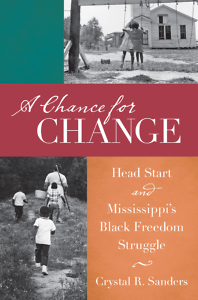In the mid-1960s, Head Start programs came to Mississippi, inspiring a new political and racial struggle in a key battleground of the civil-rights movement. In her fine new book, A Chance for Change: Head Start and Mississippi’s Black Freedom Struggle, Crystal Sanders writes of the poor black Mississippians that Head Start empowered, as well as of the white segregationists who resisted the program.
 Sanders is an assistant professor of history and African-American studies at Penn State University. Prior to her forthcoming talk at the National Civil Rights Museum in Memphis, she answered questions via email from Chapter 16:
Sanders is an assistant professor of history and African-American studies at Penn State University. Prior to her forthcoming talk at the National Civil Rights Museum in Memphis, she answered questions via email from Chapter 16:
Chapter 16: Your first chapter opens: “Education has always been political in Mississippi.” How did white segregationists use educational resources to maintain the racial order?
Crystal Sanders: Frederick Douglass asserted that “knowledge makes a man unfit to be a slave.” Slave-owners denied enslaved African Americans the right to learn to read and write, so immediately after Emancipation, black people set up schools throughout the South to combat their illiteracy. In Mississippi, the formerly enslaved transformed Big Houses into makeshift schools. The public-school systems created in the former Confederacy during Reconstruction were the brainchild and legislative fruit of black legislators, some of whom had been once been enslaved themselves.
Black public schools in Mississippi faced discriminatory funding and white hostility almost from their inception. Cotton remained king, and white planters worried that educating African Americans would thwart their ability to maintain a large and cheap black labor force. James K. Vardaman, a Mississippi politician who served in the state house, the Governor’s Mansion, and the United States Senate, asserted that educating African Americans “is to spoil a good field hand and make an insolent cook.” Such hostility to black education resulted in gross funding disparities between black and white schools. In 1915, the state spent five times more per capita on its white students than it did on its black students. By 1943, the state spent eight times as much on white education. Black parents often double-taxed themselves to make up the shortfalls.
During the civil-rights era, activists sought to offer black students an education void of notions of black inferiority. Both the 1964 freedom schools and the Child Development Group of Mississippi (CDGM) Head Start program that operated from 1965 until 1968 promoted political literacy as a tool for freedom. Students learned black history, including the black protest tradition. Students were encouraged to ask questions and to be assertive. This type of education motivated students to later challenge the racial status quo and combat white supremacist ideology.
Chapter 16: Head Start programs arrived in Mississippi in the mid-1960s, in the aftermath of Freedom Summer, when many activists were exhausted and disillusioned. Should we see these anti-poverty programs as part of the civil-rights movement?
Sanders: Anti-poverty programs of the 1960s were part and parcel of the civil-rights movement. Too often we forget that Martin Luther King Jr. said, “What good is having the right to sit at a lunch counter if you can’t afford to buy a hamburger?” We forget that the 1963 March on Washington was for freedom and jobs. While dismantling segregation and enfranchising African Americans were central goals of the civil-rights movement, economic opportunity was also on activists’ radars. Social justice cannot exist apart from economic justice.
War on Poverty programs such as Head Start gave African Americans the training, confidence, and economic independence necessary for their full political participation. White supremacists often used layoffs and evictions to prevent African Americans’ participation in electoral politics. These reprisals, coupled with the 1950s/1960s mechanization of agriculture, made antipoverty programs and the jobs they created critical to the successful implementation of nascent civil-rights legislation.
Chapter 16: One striking theme is the nature of education in the classrooms under the Child Development Group of Mississippi (CDGM). What, and how, were children taught? Why was it so important?
Sanders: CDGM aimed to nurture healthy, confident, inquisitive, happy children. Classroom experiences were participatory in nature as students were encouraged to ask questions, speak up, and say what was on their minds. The goal was to reverse the notion that children were to be seen and not heard. In CDGM, black children’s lives and their thoughts mattered. Activities such as finger painting and sculpting allowed children to expand their minds and be creative. The program made its own storybooks since standard children’s books did not portray black children. CDGM learned black history that was not taught in public schools. The curriculum bolstered children’s self-worth and prepared them to enter public schools that were predicated on white supremacy.
Chapter 16: A Chance for Change highlights the role of working-class black women. When we analyze their participation in these Head Start programs, how might it change our larger perspective on the civil-rights movement?
Crystal Sanders: I don’t think black women’s large-scale participation in CDGM changes our perspective on the civil-rights movement so much as it adds to what we know. There is a vast amount of scholarly literature demonstrating that women played integral roles in the freedom movement. We know that black women mobilized in a variety of venues including churches, beauty parlors, and civic clubs to protest racial discrimination. My work shows that Head Start, a federal early childhood education program, became another avenue for their social-justice work.
Chapter 16: When CDGM started, it seemed to be universally despised by Mississippi whites, from Senator John Stennis to Ku Klux Klansmen. Why? How did segregationists resist and modify these federal programs?
 Sanders: White supremacists opposed CDGM because the program gave black Mississippians control over large sums of federal money and allowed them to control something other than black churches. These segregationists knew that once working-class African Americans realized that they could successfully run Head Start, they would also attempt to run towns and school boards.
Sanders: White supremacists opposed CDGM because the program gave black Mississippians control over large sums of federal money and allowed them to control something other than black churches. These segregationists knew that once working-class African Americans realized that they could successfully run Head Start, they would also attempt to run towns and school boards.
Dating back to Emancipation, whites had used economic reprisals to control the mobility and political activity of African Americans. CDGM upset that arrangement as it provided jobs to black Mississippians independently of the local white power structure. Additionally, segregationists saw the confidence that Head Start fostered. If poor black citizens could run Head Start centers, they could also vote and make decisions for themselves. Finally, many opposed CDGM’s program because it was the first time that white Mississippians had not been able to monitor, limit, and filter what black children learned.
Segregationists attempted to weaken CDGM in a variety of ways. Klansmen intimidated and physically attacked Head Start teachers. They also vandalized many Head Start centers, even destroying one center with arson. White elected officials including United States Senator John C. Stennis (D-MS) questioned the program’s bookkeeping and the qualifications of the program staff. Stennis’s attacks eventually led to CDGM’s end.
Chapter 16: CDGM lost its federal funding to another anti-poverty agency, Mississippi Action for Progress (MAP). How did this transfer highlight political tensions within Mississippi?
Sanders: When it appeared that Senator Stennis would use his position on the Senate Appropriations Committee to endanger the entire anti-poverty effort, War on Poverty director Sargent Shriver moved to replace CDGM with MAP. MAP, operated by an interracial group of middle-class moderates, was more acceptable to the state’s white power structure because poor blacks no longer ran the show.
The about-face on Shriver’s part, given his earlier support of CDGM, demonstrated the tensions that existed among various levels of government with respect to anti-poverty programs. Most importantly, MAP’s founding suggested that the federal government would not be working-class black Mississippians’ unwavering ally in the anti-poverty effort.
Chapter 16: It seems possible to read your book as both an inspiration for genuine social change and as a cautionary tale about how powerful institutions hold onto that power. Is the CDGM story a triumph or a tragedy?
Sanders: The CDGM story is not one of triumph or tragedy. It is the story of what is possible when ordinary citizens are given seats at decision-making tables. Quite simply, CDGM was a chance for change. Even after the program ended, CDGM employees used the knowledge gained through Head Start to continue improving their communities.

Aram Goudsouzian chairs the history department at the University of Memphis. His most recent book is Down to the Crossroads: Civil Rights, Black Power, and the Meredith March Against Fear.
Tagged: Nonfiction





